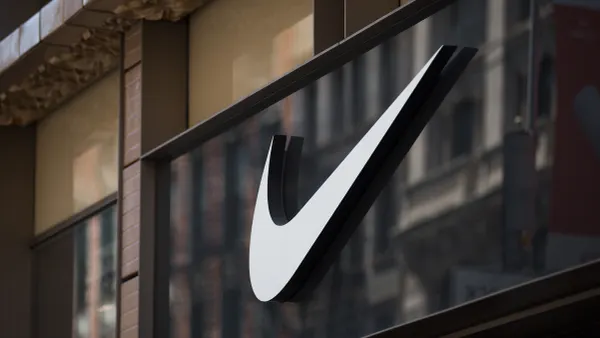Dive Brief:
- Shifting to a digital-first distribution strategy, "daily global demand and supply optimization" and tight cost management are major tenets of what Nike executives called their "coronavirus playbook" on a Tuesday earnings call.
- "Our measures of success in the near-term will be rooted in the amount of inventory on hand relative to the pace of digital demand, store re-openings and traffic patterns," CFO Andy Campion said.
- Nike saw gross margin decline 80 basis points to 44.3%, with a 5% bump in revenue, in the quarter ending Feb. 29, and Campion said there would be more margin erosion ahead. But Nike's operational prowess and liquidity will allow the company to snap back whenever consumer demand returns while keeping and paying employees, newly installed CEO John Donahoe said on the call.
Dive Insight:
"We'll continue to maintain pay continuity, even while our facilities are closed or have altered schedules. We know that our people are vital to fueling our deep connections with consumers, whether they work in our stores or in our distribution centers," Donahoe said. "And what's more, it's simply the right thing to do."
Though confident in their ability to come out of the coronavirus crisis stronger than before, Nike executives insisted to investors and analysts that this time in global business history will need to be graded on a curve.
"Margin and inventory growth rates will neither be intuitive nor linear," for the affected period Campion warned. Wholesale orders will be canceled and retailers will promote heavily, but none of these actions should be taken as trends, the CFO said.
Nike's supply chain may be uniquely positioned to withstand violent demand swings as COVID-19 makes its way across the world. The company has focused for over a year on using data to fine-tune operations with an emphasis on inventory visibility and demand sensing.
In June, former CEO Mark Parker said the company was tracking nearly all of its non-licensed apparel and footwear with RFID tags in order to gain the inventory visibility to give customers exactly what they want fast. In an environment of depressed consumer demand, the importance of inventory positioning will go up as restrictions on labor and movement hamper full-tilt warehouse operations.
"The foundation we’ve built in enterprise data and analytics is fueling our more agile end-to-end execution," Campion said." As we said, we're still in the early earnings of Nike’s digital transformation, but the capabilities we've already been building for the future are proving to be the strongest pillars within our business today."
Digital retailers who are already set up to share inventory data with Nike will help the brand maintain precisely-tuned global inventory levels, Donahoe said.
Inventory data, as well as consumer data from retail partners and Nike's own digital sales channels, will feed digital demand sensing tools the company has been developing to inform product development and order size — though the company is already aware that product launches will likely be delayed.














